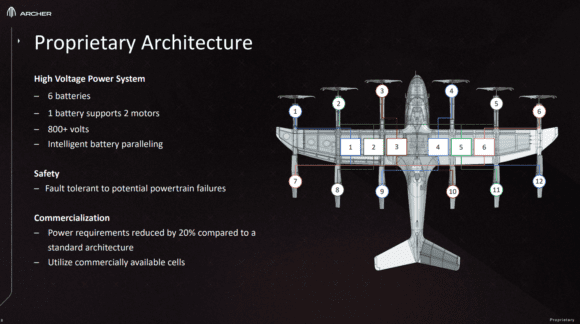
315902749 481588860733964 8412291984539799500 n
Archer Aviation has unveiled the production version of its eVTOL vehicle, which it hopes to get certified in the second half of 2024 and enter service in 2025. The Midnight is the successor of the Maker demonstrator that has been used for testing. Archer unveils Midnight and lays out its plans.
The Midnight is significantly longer than the Archer, but retains its architecture with a fixed wing, a carbon-composite fuselage, and a V-shaped tailplane. It is powered by twelve electric motors that are positioned on booms, with the front motors able to tilt for forward flight as is used on most eVTOLs we have seen so far.
Archer highlights the safety of the Midnight. The propulsion system has been developed in-house. Its redundancy and simplicity should make the Midnight significantly safer than a conventional helicopter. “Midnight has no single critical points of failure, meaning that should any single component fail, the aircraft can still safely complete its flight. In addition, the electric motors used in Midnight have significantly fewer moving parts than those found in a gas turbine or piston engine, allowing it to operate with less maintenance and lower overall risk.” At 45 dBA, the noise of the eVTOL will be around 1.000 times lower compared to a helicopter.
The configuration of the twelve electric motors and six batteries on the Midnight. (Archer)
The four-seater vehicle plus a pilot is designed for short taxi flights of around twenty to fifty miles/32-80 kilometers. After each flight, the six batteries of the high-voltage (800 Volts) power system will require recharging, which will take some twelve minutes. Archer says it uses proven battery technology with demonstrated reliability. The motors are designed for 10.000 missions.
The Maker hasn’t been pensioned off and will still be used. Notably, it is scheduled to make the first transition flight in the coming weeks, in which the vehicle will demonstrate it can move from hover to forward flight. Using the identical architecture, lessons learned on the Maker can be used for the Midnight program.
Gearing up production to 2.000 a year
In its Open House presentation today, Archer said it will submit its certification basis for the Midnight in the federal register this quarter and expects the FAA to approve the means of compliance in Q4 as well. HY1 of 2023 will be dedicated to submitting more specific certification plans and getting approval in HY2. The Midnight prototypes will be constructed in 2023 and start flight testing during the year, leading up to certification in HY2 of 2024.
Archer also shared some details of its industrialization plans. It intends to scale up the production capability between 2024 to 2028 to up to 2.000 Midnights per year, reaching volume manufacturing by the end of this timeframe. Midnights should be flying out of and into existing or converted helipads at high-rate flight operations. United Airlines announced earlier this week that it plans to launch eVTOL services between New York City and Newark Airport once the vehicle gets certified. The airline is Archer’s flagship customer”, with 100 Midnights on firm order plus 100 options worth $1.5 billion. Archer says it is “engaged with other major US airlines about the potential sale of our aircraft.”
“We continue the push towards commercialization, with the vast majority of our resources focused on completing the development and certification of Midnight, building out our manufacturing and supply chain capabilities, and hardening our go-to-market plans,” said Mark Mesler, Archer’s CFO, in a media statement.
Archer will continue to develop the Midnight to include the latest in battery and engine technology, and further improve acoustics. It also says that beyond 2028, it will look at technology for autonomous flying. Its competitor Wisk, which is strongly supported by Boeing, has developed its eVTOL for autonomous flight in mind from day 1.
Views: 319




